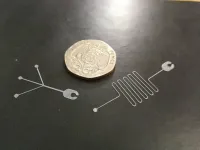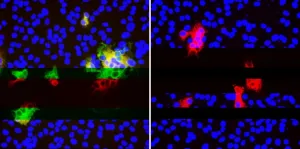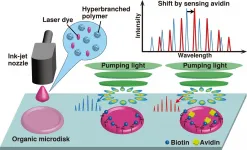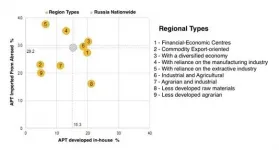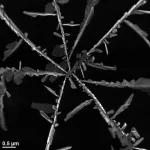(Press-News.org) Narrowing of the trachea or the main bronchi due to injury or illness can end very badly. If patients get too little air,oxygen, they risk suffocating and often need medical help as quickly as possible.
Surgeons insert stents made of medically usable silicone or metal as a way of treating these patients. Although they quickly bring relief, the implants also have disadvantages: Metal stents have to be removed surgically with some effort, which is a burden for the patients, while silicone stents often migrate away from the insertion site. The reason for this is that the implants are not adapted to a patient's anatomy.
An ETH Zurich research team, composed of members of the Complex Materials and Drug Formulation and Delivery groups, has now developed an airway stent together with researchers from the University Hospital Zurich and the University of Zurich; it is tailored to patients and bioresorbable, (i.e., it gradually dissolves degrades after implantation). These stents are manufactured using a 3D printing process known as digital light processing (DLP) and light-sensitive resins specially adapted for this purpose.
First, the researchers create a computer tomography image of a specific section of the airways. Based on this, they develop a digital 3D model of the stent. The data is then transferred on to the DLP printer, which produces the customised stent layer by layer.
In the DLP process, a building platform is immersed in a reservoir full of resin. The platform is then exposed to UV light at the desired locations according to the digital model. Where light hits the resin, it hardens. The platform is lowered a little and the next layer is exposed to the light. In this way, the desired object is created layer by layer.
Special resin developed
Until now, DLP technology could only produce stiff and brittle objects using biodegradable materials. The ETH researchers, therefore, developed a special resin that becomes elastic after light exposure.
This resin is based on two different macromonomers. The material properties of the object produced with it can be controlled by the length (molecular weight) of the macromonomers used and by their mixing ratio, as the researchers show in their latest study in Science Advances.
As soon as UV light hits the resin, the monomers link together and form a polymer network. Since the newly developed resin is too viscous at room temperature, the researchers had to process it at temperatures of 70 to 90 degrees Celsius.
The researchers produced several resins with different monomers and tested the prototypes they made from them to see whether the material is cell-compatible and biodegradable. They also tested the prototypes for elasticity and for mechanical stress such as compression and tension.
Finally, the scientists used the material with the desired properties to make stents, which were tested on rabbits.
Inserting the stents also requiredd a special instrument, as the 3D-printed objects have to be delivered folded. This requires that the iThe implants cannot be kinked or squeezed in the wrong direction and that they have to unfold perfectly at their site of deployment.
The researchers included gold in the stent's structure in order to facilitate the use of medical imaging to track its location during insertion. This makes the stent more robust, but does not change its tolerability.
Successful tests, good prospects
The tests on the rabbits conducted by the research group of Daniel Franzen, Senior Physician at the Department of Pneumology at the University Hospital Zurich, and the Vetsuisse faculty were successful. The researchers were able to show that the implants are biocompatible and that they are absorbed by the body after six to seven weeks. Ten weeks after implantation, the stent was no longer visible on X-ray images. In addition, the inserted stents generally did not move from their insertion site.
"This promising development opens up prospects for the rapid production of customised medical implants and devices that need to be very precise, elastic and degradable in the body," says Jean-Christophe Leroux, Professor of Drug Formulation and Delivery at ETH Zurich. Further research will focus on making the insertion of the stents as gentle as possible.
Furthermore, the processes are to be designed in such a way that production is possible at the point of use, or at least would involves short supply chains. The process is still on a laboratory scale. "However, producing such stents on a large scale is a complex undertaking that we still need to study better," says André Studart, head of the Complex Materials Group at ETH. However, he says the technique can be transferred relatively easily to similar medical applications. "It is therefore hopefully only a matter of time before our solution finds its way into the clinic," says the professor.
INFORMATION:
New technology developed by the University of Bristol has the potential to accelerate uptake and development of on-chip diagnostic techniques in parts of the world where rapid diagnoses are desperately needed to improve public health, mortality and morbidity.
Microfluidic devices underpin lab-on-a-chip (LOC) technologies which are developed to provide the rapid diagnoses at that are needed at point of care (POC) for the swift and effective treatment of many diseases.
Researchers at Bristol have developed a fast, reliable and cost-effective alternative for producing the soft-lithographic moulds used for fabricating microfluidic devices, published in the journal ...
PITTSBURGH, Feb. 3, 2020 - In a recurring pattern of evolution, SARS-CoV-2 evades immune responses by selectively deleting small bits of its genetic sequence, according to new research from the University of Pittsburgh School of Medicine.
Since these deletions happen in a part of the sequence that encodes for the shape of the spike protein, the formerly neutralizing antibody can't grab hold of the virus, the researchers report today in Science. And because the molecular "proofreader" that usually catches errors during SARS-CoV-2 replication is "blind" to fixing deletions, they become cemented into the variant's genetic material.
"You can't ...
Researchers have identified a pattern of deletions in the spike (S) glycoprotein of SARS-CoV-2 that can prevent antibody binding. Virus lineages featuring this mechanism are currently being transmitted between individuals globally, they say. Their results - reported after analyzing nearly 150,000 S gene sequences collected from many parts of the world - exhibit a form of virus "escape" that resulted from a common, strong selective pressure; for example, the authors identified at least nine instances where deletion variants arose in patients whose COVID-19 infections were persistent. So far, the strongest indicator of protection against SARS-CoV-2 appears to be humoral immunity, such as by antibodies, ...
WASHINGTON -- Researchers have developed a unique inkjet printing method for fabricating tiny biocompatible polymer microdisk lasers for biosensing applications. The approach enables production of both the laser and sensor in a room temperature, open-air environment, potentially enabling new uses of biosensing technologies for health monitoring and disease diagnostics.
"The ability to use an inexpensive and portable commercial inkjet printer to fabricate a sensor in an ambient environment could make it possible to produce biosensors on-site as needed," said research team leader Hiroaki Yoshioka from Kyushu University in Japan. "This could help make biosensing widespread even in economically disadvantaged ...
Coffee rust is a parasitic fungus and a big problem for coffee growers around the world. A study in the birthplace of coffee - Ethiopia - shows that another fungus seems to have the capacity to supress the rust outbreaks in this landscape.
"Coffee leaf rust is a fungal disease that is a problem for coffee growers around the world, especially on Arabica coffee, which accounts for three quarters of global coffee production and has the finest cup quality. There is a need to learn more about natural solutions instead of just applying pesticides," says Kristoffer Hylander, professor at the Department of Ecology, Environment and Plant Sciences (DEEP) at Stockholm ...
Many nations place drugs into various schedules or categories according to their risk of being abused and their medical value. At times, drugs are rescheduled to a more restrictive category to reduce misuse by constricting supply. A new study examined lessons from past efforts worldwide to schedule and reschedule drugs to identify general patterns and found that rescheduling drugs can lower use as well as the dangers associated with the drug. The findings have implications for policy.
The study, by researchers at Carnegie Mellon University (CMU), is published in the International Journal of Drug Policy.
"Our review suggests that rescheduling drugs can often disrupt trends in prescribing, use, or harms," says Jonathan Caulkins, professor of operations research and public policy at CMU's ...
In the first longitudinal study to follow Georgia pre-K students through middle school, Stacey Neuharth-Pritchett, associate dean for academic programs and professor in UGA's Mary Frances Early College of Education, found that participating in pre-K programs positively predicted mathematical achievement in students through seventh grade.
"Students who participated in the study were twice as likely to meet the state standards in their mathematics achievement," said Neuharth-Pritchett. "School becomes more challenging as one progresses through the grades, and so if ...
Russian enterprises have limited opportunities to carry out technological modernisation on their own. Their technological portfolios reveal a high dependence on imported solutions and a limited deployment of their own developments, HSE University researchers discovered.
In recent years, there has been a growing demand for the use of advanced manufacturing technologies (AMT) in Russia. Between 2011 and 2018, the number of AMT used increased by 33%, and in 2018 they amounted to almost 255,000 units in absolute terms. Meanwhile, innovation strategies focused on independent development of novel manufacturing solutions are not widespread in Russia. Fewer than ...
GROUND-BREAKING research from the University of Huddersfield, announced ahead of World Cancer Day 2021, proves that scalp cooling physically protects hair follicles from chemotherapy drugs. It is the world's first piece of biological evidence that explains how scalp cooling actually works and the mechanism behind its protection of the hair follicle.
The study, entitled 'Cooling-mediated protection from chemotherapy drug-induced cytotoxicity in human keratinocytes by inhibition of cellular drug uptake', has been published in the peer-reviewed journal PLOS ONE .
The data was part of an innovative hair follicle research project carried out by the dedicated Scalp Cooling ...
Antimicrobial packaging is being developed to extend the shelf life and safety of foods and beverages. However, there is concern about the transfer of potentially harmful materials, such as silver nanoparticles, from these types of containers to consumables. Now, researchers reporting in ACS Applied Materials & Interfaces illustrate that silver embedded in an antimicrobial plastic can leave the material and form nanoparticles in foods and beverages, particularly in sweet and sugary ones.
Some polymers containing nanoparticles or nanocomposites can slow ...
